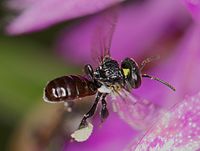
Photo from wikipedia
ETHNOPHARMACOLOGICAL RELEVANCE The Acanthus genus belongs to the Acanthaceae family, and its species are distributed in all continents, mainly in tropical and subtropical regions. Several traditional applications are referred to,… Click to show full abstract
ETHNOPHARMACOLOGICAL RELEVANCE The Acanthus genus belongs to the Acanthaceae family, and its species are distributed in all continents, mainly in tropical and subtropical regions. Several traditional applications are referred to, but few scientific studies validate them. Despite this, studies in animal models corroborate some of its uses in folk medicine, such as anticancer, antidiabetic, anti-inflammatory, and antinociceptive, which encourages the research on plants of this genus. AIM OF THE REVIEW To our knowledge, this document is the first comprehensive review study that provides information on the geographic distribution, botanical characteristics, ethnomedicinal uses, phytochemicals, and pharmacological activities of some Acanthus species to understand the correlation between traditional uses, phytochemical, and pharmacological activities, providing perspectives for future studies. RESULTS In traditional medicine, Acanthus species are mainly used for diseases of respiratory, nervous and reproductive system, gastrointestinal and urinary tract, and skin illness. The most used species are A. montanus, A. ilicifolius, and A. ebracteatus. Chemical compounds (125) from different chemical classes were isolated and identified in seven species, mainly from A. ilicifolius, about 80, followed by A. ebracteatus and A. montanus, appearing with a slightly lower number with fewer phytochemical profile studies. Isolated phytoconstituents have been mainly alkaloids, phenylpropanoid glycosides, and phenylethanoids. In addition, aliphatic glycosides, flavonoids, lignan glycosides, megastigmane derivatives, triterpenoids, steroids, fatty acids, alcohols, hydroxybenzoic acids, simple phenols were also cited. Scientific studies from Acanthus species extracts and their phytoconstituents support their ethnomedical uses. Antimicrobial activity that is the most studied, followed by the antioxidant, anti-inflammatory, and anticancer properties, underlie many Acanthus species activities. A. dioscoridis, A. ebracteatus, A. hirsutus, A. ilicifolius, A. mollis, A. montanus, and A. polystachyus have studies on these activities, A. ilicifolius being the one with the most publications. Most studies were essentially performed in vitro. However, the anticancer, antidiabetic, anti-inflammatory and antinociceptive properties have been studied in vivo. CONCLUSION Acanthus species have remarkable phytoconstituents with different biological activities, such as antioxidant, antimicrobial, anti-inflammatory, antinociceptive, hepatoprotective, and leishmanicidal, supporting traditional uses of some species. However, many others remain unexplored. Future studies should focus on these species, especially pharmacological properties, toxicity, and action mechanisms. This review provides a comprehensive report on Acanthus genus plants, evidencing their therapeutic potential and prospects for discovering new safe and effective drugs from Acanthus species.
Journal Title: Journal of ethnopharmacology
Year Published: 2022
Link to full text (if available)
Share on Social Media: Sign Up to like & get
recommendations!